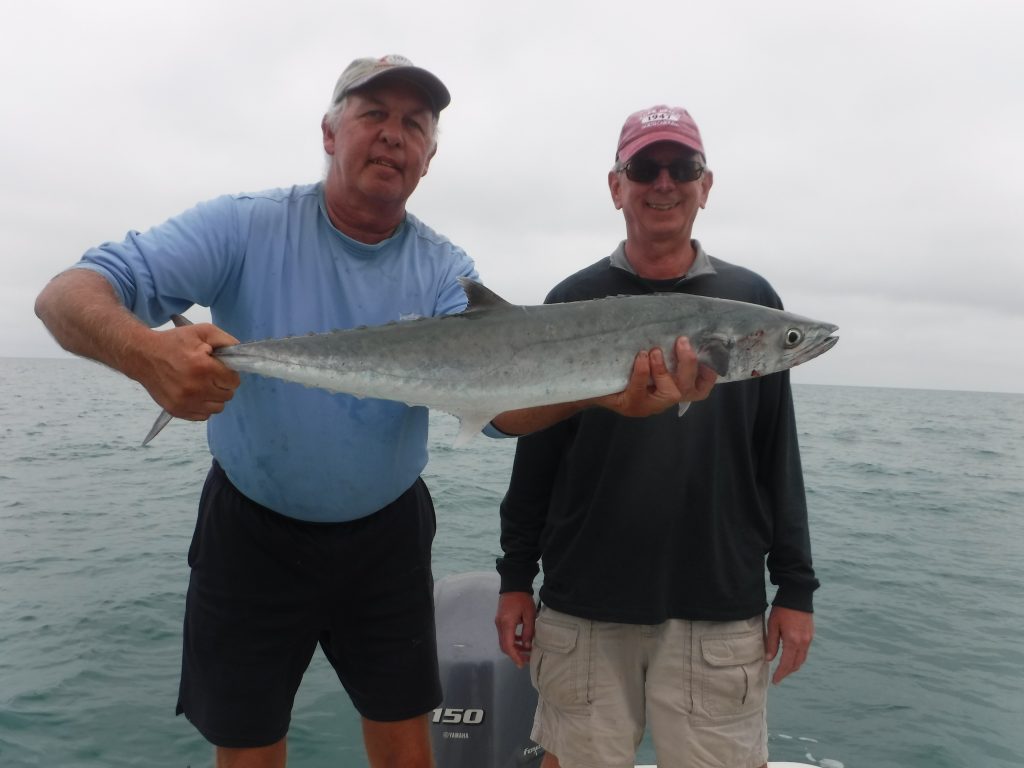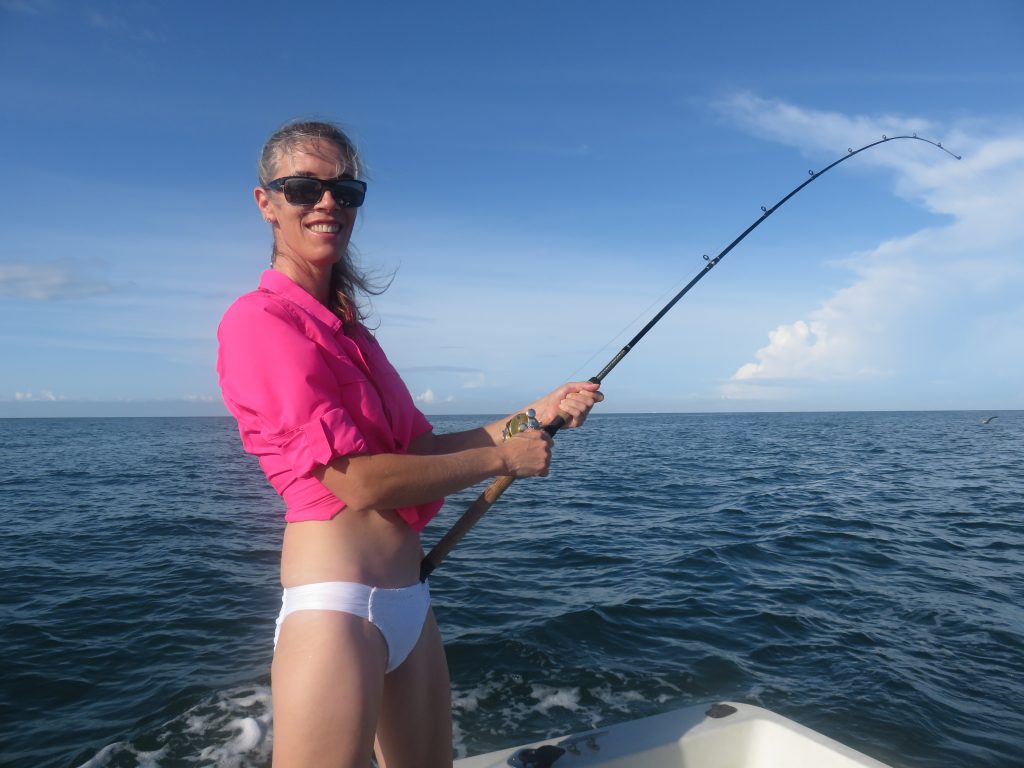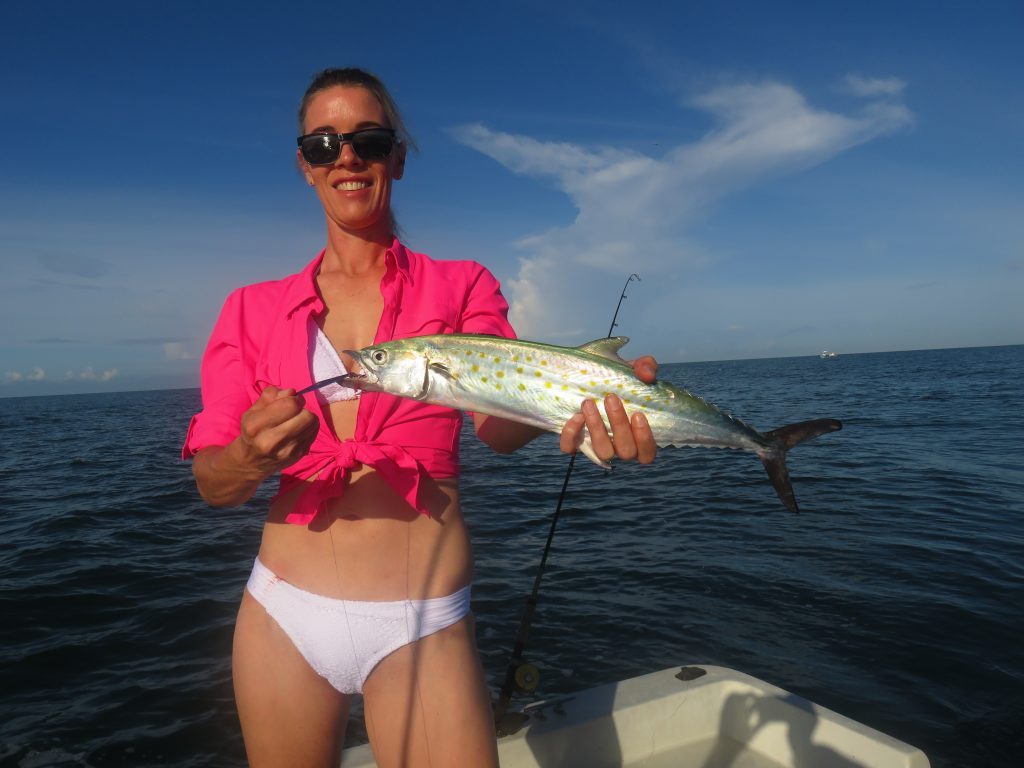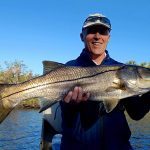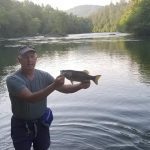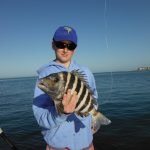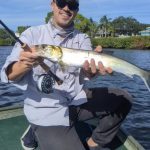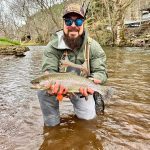Trolling in Saltwater, Tips, Tackle, and Techniques
In this article I will share some great information and tips on trolling in saltwater. Trolling is a very effective technique that will produce a wide variety of species. For the most part, the article will concentrate on light and medium tackle trolling in relatively shallow water.
Trolling in its basic form is the act of fishing while pulling lures or baits behind a moving boat. This allows anglers to cover a lot of water quickly and efficiently. Trolling will also produce both numbers of fish and quality sized fish. Lure selection, tackle, depth, speed, and distance behind the boat are all critical factors to achieving success when trolling. I will cover all of those aspects in this article.
Best trolling tackle
Conventional tackle is the best choice best choice for anglers trolling in saltwater. Spinning tackle can be used, however there is a large strain on the spindle. Conventional outfits have better drags, more line capacity, and more power. Fortunately, there are a wide variety of options that are both versatile and affordable.
The best trolling rods have a fairly fast action. That means that they are strong in the butt section but become very limber towards the tip. This limber tip is very important when trolling. A 7 foot medium fast action trolling rod paired with a 30 series conventional real is a great all round choice. This is light enough to enjoy the fight of a Spanish mackerel while being heavy enough to land a larger fish.
Here is a quality Penn combo at an affordable price. Click on the link to purchase or shop on Amazon
“Fishing Lido Key is a participant in the Amazon Associates Program, an affiliate advertising program designed to provide a means for sites to earn advertising fees by advertising and linking to Amazon. As an Amazon Associate I earn from qualifying purchases.”
Rigging up for trolling
I use a variation of the same basic rig for all of my trolling. First off, I double about 5 feet of the running line using a Uni Knot. If I’m using a plug or live bait rig, I then add a 3 foot to 5 foot section of shock leader. This will vary depending on the size of the fish being pursued. When using planers or trolling sinkers, I simply tie either right to the double line.
While some anglers use wire leaders, I rarely do. The best water conditions for anglers trolling are clear, calm waters. I just find that under these conditions wire reduce the strikes. Surprisingly, I experience relatively few cutoffs using fluorocarbon leader, especially on the spoons. Once in a while a large king mackerel will bite off a plug, but this is the cost of doing business.
Trolling with plugs
Perhaps the easiest way to to start trolling is to do so with diving plugs. This type of trolling is very easy as there is minimal hardware involved. Plugs are available in many different sizes, shapes, and colors. They all have a bill on the front which to a large degree determines the depth that which the plug will dive. Most manufacturers have a fairly reliable chart that will help anglers decide which plug to use. Most advertised depths are optimistic, the plug will usually not dive as deep as listed.
As a fishing guide in Florida, I have had many trips saved by trolling. At times I get anglers with very little experience. But, anyone can sit there and hold the rod while waiting for a fish to strike. Spanish mackerel, striped bass, bluefish, trout, false albacore, jacks, ladyfish, and more will hit a trolled plug.
My favorite lure for this type of trolling is a Rapala X-Rap Xtreme Action Slashbait. This bait has a lot of action and will dive down several feet below the surface. White and olive are my top colors. The 08 size perfectly matches the smaller bait we have in Florida. Anglers should match the plugs being trolled to the locally available forage that game fish are feeding on. This bait has produced many Spanish mackerel and other species for clients over the years. This is one application where spinning tackle is fine as the lures are quite small.
As mentioned above, anglers using larger plugs will do best with light conventional outfits. A 5 foot fluorocarbon leader of 80 pound test is a good all-around choice. Larger plugs are very effective for king mackerel, false albacore, and other species for anglers trolling the inshore Gulf of Mexico and Atlantic Ocean.
Top plugs for trolling in saltwater
Top plugs are the Bomber Long A, Yozuri Crystal Minnow, and #12 Rapala X-Rap. These are all effective and proven lures. The best approach is to choose a size and finish which matches the local forage. Local bait shops can often help out with this. Anglers should by their baits with several different lips in order to cover the entire water column. Most of these plugs do have multiple treble hooks, which make releasing fish a bit more difficult.
One tactic that is grown in popularity within the last decade is trolling deep diving plugs for gag grouper. This is particularly effective in the cooler months when grouper migrate in closer to shore and holdover shallow water ledges and structure. The Mann Stretch 30 were the first plugs designed for this type of fishing and still work well.
Trolling with plugs is very easy. This is one of the attractions, as anyone can do it. Once rigged up, the plug is let out a distance behind the boat, the the reel engaged, and the rod is put in a stern rod holder. The angler then drives around a bit above idle speed and search of fish. The drags should be set fairly loose so that when a fish is hooked the plug is not ripped out of its mouth.
Light tackle trolling in saltwater with jigs
Jigs are another lure that anglers can control fairly easily. Jig heads come in a myriad of different sizes and shapes. Most opt for the shad tail style baits as they have an enticing swimming action and mimic the local forage. Curly tail jigs work well, too, but the tail can be bitten off more easily. Torpedo or triangular-shaped heads are generally the most effective jig head style.
Anglers can use jig head weight and boat speed to reach the desired depth. Generally speaking, jigs need to be trolled fairly slowly or they tend to twist and roll. Striped bass fisherman in the Northeast catch a lot a fish by trolling jigs! A white buck tail jig with a 4 inch to 5 inch shad tail grub is a great all round combination. Jigs can be trolled behind the trolling sinkers and planers as well. More on that as we go forward.
Trolling with spoons
Spoons are incredibly effective lures for anglers trolling in saltwater. Trolling spoons are specially designed, being long and slender. This produces a very tight wiggle, allowing anglers to troll up to 8 knots. When pulled through the water, they have a very erratic and enticing action. The most popular spoons are silver, which matches most bait fish found in open water. Most spoons have one single hook, which makes handling fish and releasing them much easier.
Spoons are light and some type of device must be used to get them down in the water column. Trolling sinkers and planers are most often used to do so. Sinkers are simply weights with swivels at each and that are tied in line between the running line and the leader.
Click this link to shop Amazon for Clark spoons
The rig consists of the trolling sinker, a length of fluorocarbon leader, a snap swivel, and the spoon. Leader lengths vary, with 10 foot to 15 foot leader is being the most effective. Obviously, the heavier the sinker the deeper the lure will go. However, this will be limited by the speed somewhat. This is especially true when trolling between 5 kn and 7 kn, which is a common speed for most inshore saltwater trolling.
Using trolling sinkers
3 ounces is a good all-around size for this type of light tackle trolling. There are a couple of different sinker designs; keel sinkers and torpedo sinkers. Both work fine, it is really just a matter of angler choice and what is available. These sinkers do have swivels at the front and rear which will help reduce line twist.
Trolling with this sinker rig is fairly simple. With the boat in gear, the spoon is dropped in the water and the leader played out by hand. The sinker is then put in the water and as the boat moves along line is played out behind the boat to a determined length. The rod is then put in the holder while the boat trolls in search of fish.
When a fish is hooked, the rod is removed from the holder and the angler fights the fish. If there is more than one line out, the boat must maintain forward motion or the other line will sink to the bottom and snag. Once the sinker is a foot or so away from the rod tip, the angler stops reeling backs up in the fish is hand lined in the rest of the way.
Light tackle trolling in saltwater with planers
Planers are clever devices that are used to get spoons and other lures down in the water column. They work similarly to diving plugs, but with a neat little twist. The planer has a sliding ring on it. The running line is attached to this ring. When the planer is set, with the sliding ring at the top, it digs down into the water causing the planer and the lure to run at a desired depth.
When a fish strikes, the planer “trips”, resulting in the ring sliding to the back. This allows the angler to fight the fish unencumbered by the pull or dig of the planer. As with the trolling sinker, once the planer is a foot or so from the rod tip, the angler walks backward while another hand lines the fish in the rest of the way.
Planer sizes
Planers come in sizes. A #1 planer will dive down 5 to 7 feet it is perfect for anglers pursuing Spanish mackerel and false albacore. A snap swivel is attached to the back of the planer. A 20 foot long fluorocarbon leader of 50 pound test followed by a spoon completes the rig.
A #2 planer will dive down 12 to 15 feet or so. This rig will catch a lot of king mackerel and striped bass. The rig is similar to a number one planer with an increase in leader strength. A snap swivel is attached to the end of the planer and a 20 foot long fluorocarbon leader of 80 pound test followed by the spoon completes the rig.
Click this link to shop Amazon for planers
A #3 planer will dive down to 25 feet or more. However, this pushes the definition of “light tackle trolling” and a fairly stout rod is required to hold up under the strain of a number three planer. Some anglers tie the #3 planer to a cleat then run a separate line with the lure attached to a clip, similar to a downrigger. This is complicated, but will get the lure down deep.
Spoon size with planers
There are no real restrictions as to the size of the spoon that can be used with the planer. Large spoons can be used on the # 1 planer and small spoons can be used on the # 2 planer. The purpose of the planer sizes is to vary the depth in the water column at which the lures can be trolled. Planers also work well at high speeds of up to eight or even 10 knots without spinning or twisting. For most anglers trolling with planers, 5 to 7 knots is the perfect speed.
A productive trolling spread
Setting up the trolling spread is very important. Doing so incorrectly will result in tangled lines and angler frustration. One basic principle that will help anglers is to keep the deepest lines in close and the shallowest lines further back. Having several lines at different depths and different distances will allow anglers to make turns without the lines tangling. Conversely, having several lines the same distance back at the same depth almost ensures a tangled mess.
The following spread is one that I use often on my charters and is worked well for me. I do this mostly in the inshore Gulf of Mexico when trolling for king mackerel, Spanish mackerel, and false albacore. However, it will produce just as well in any open water that is 20 feet deep or deeper.
With the boat in gear and idling forward, I put out a shallow diving plugs such as a Rapala X-Rap. I free spool the reel and count the line back for 25 seconds. I then locked the reel and put the rod in a port holder.
Putting out the trolling lines
Next, on the starboard side, I deploy the #1 planer, counting it back for 20 seconds and placing it in a starboard rod holder. Finally, I deploy the #2 planer, counting it back 15 seconds and placing it in the other port rod holder.
The result is three lures running at various depths from right under the surface to 15 feet down and at varying distances behind the boat. This will cover the water column efficiently while allowing me the option to make turns and adjust course to cover structure or when I see fish on the surface.
Anglers in smaller boats or just starting out may choose to stick with two lines. Fishing a #1 and #2 planer will catch a lot of fish while helping the angler gets some experience trolling.
Live bait trolling
Anglers can also troll using live bait fish. This is a bit of a specialized tactic that tends to produce less fish, but larger ones. A rig called a “stinger rig” is used. This is a wire leader about 3 feet long with two hooks on it. The forward hook is used to go through the nose of the bait and the rear hook either swings free or is lightly embedded in the top of the bait fish.
This rig is very effective. The front hook keeps the bait going straight while most of the fish are hooked on the rear hook. This rear hook is most often a trouble hook. King mackerel in particular are famous for clipping a bait fish and half and this rear hook, or stinger hook, will catch them. Anglers need to set the drag light to prevent the hook from pulling.
The best baits for slow trolling are blue runners ( AKA hard tails), cigar minnows, large scaled sardines, and threadfin herring. Blue runners are the preferred bait as a are quite hardy and troll well. Often times, anglers trolling with spoons will pick up blue runners while seeking mackerel. They can then be saved for slow trolling later. Sabiki rigs dropped down in schools of bait or over structure will put enough baits to fish with in the well in short order.
Anglers troll very slowly when using this technique. It is best suited for fishing a smaller area such as an artificial reef or where a school of fish has already been located. We lines are another good spot to slow troll. Larger boats actually have special devices to keep the boat moving slowly enough. The idea is to make just enough headway to keep the line tight in the bait swimming naturally in the water.
Trolling with live shad and herring is extremely effective in freshwater lakes for striped bass. These game fish thrive in pure fresh water and have been successfully stocked in many large reservoirs throughout the country.
Productive spots to troll
Anglers trolling will seek out the same areas as they would using any other type of fishing method. Here on the West Coast of Florida where I fish, the Gulf floor is relatively barren. This means that any type of structure will generally hold bait and game fish. Ledges and artificial reefs are top spots.
Structure is always a great place to start trolling. However, fish will often times be found in open water as well. This usually occurs as a are herding up bait fish. Anglers should keep their eye on the horizon, searching for any signs of surface activity and birds working. Birds sitting on the surface or wheeling and diving are great indications that feeding fish are in the area.
Working breaking fish is very exciting! There’s nothing better than seeing a large area of the surface a rubbed as bluefish, striped bass, Spanish mackerel, false albacore, and other species devour helpless bait fish. The best approach is to skirt the school with the boat then once clear turn the wheel so that the lures passed through the feeding fish. Driving the boat through the middle of the fish will put them down and anger your fellow anglers.
Trolling in shallow water
Trolling works well in shallow water and should not be overlooked by anglers as well. Shallow diving plugs such as that #8 Rapala X-Rap are very productive. They allow anglers to cover a lot of water and it is a great way for novice anglers to catch a few fish. Submerged grass beds and flats are great areas to troll inshore.
In Chesapeake Bay, Pamlico sound, and other large shallow bays, trolling produces a lot a fish. Jigs are often a top choice for anglers trolling for striped bass in flounder in these waters. Channel edges are prime spots where a flat drops down into deeper water. Fish will often times hold right on the edge and ambush prey.
In conclusion, this article on light tackle trolling in saltwater will help you master this incredibly productive fishing technique!
